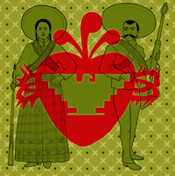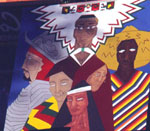


Pictures
Template
http://www.coloarts.state.co.us/assets/Chicano-mural.jpg
http://ideasandsociety.ucr.edu/chicanoconference/imagesf/frontpage_20.gif
Home Page
http://www.albany.edu/jmmh/vol3/chicano/logo.gif
http://www.esl-english.com/english-place/interviews/mexican-flag.gif
Background
http://www.cnn.com/WORLD/americas/9902/15/us.mexico/story.us.mexico.jpg
http://www.dlh.lahora.com.ec/paginas/infantila/entorno35.htm
http://aztlan.net/cesartribute.gif
http://www.albany.edu/jmmh/vol3/chicano/corky.gif
http://www.stoptheinvasion.com/AZTLAN%20MAP.jpg
http://www.mexika.org/PNLRU.gif
http://www.kqed.org/w/snapshots/images/photo_05_01.jpg
Art
http://www.devocionario.com/imagenes/guada3.jpg
Gallery
http://cemaweb.library.ucsb.edu/chicanoArt.html
Artist Bios
http://www.cac.ca.gov/migrant/center093004.htm
http://www.postartgroup.com/galls/mm/xtra1.html
http://archivesofamericanart.si.edu/images/ybartoma/califas3.jpg
http://cemaweb.library.ucsb.edu/louie_the_foot.html
Gallery and Artist Biography Bibliography
"Biography," Esterhernandez.com, http://esterhernandez.com/Bio_1.htm.
"Louie 'The Foot' Gonzalez," Latino/a Art Community, http://latinoartcommunity.org/community/ChicArt/ArtistDir/LouGon.html.
"Luna's Cafe Gallery: Armando Cid," Luna's Cafe, http://www.lunascafe.com/gallery.htm
"Murals at the Centro," Centro Cultural de La Raza, http://www.centroraza.com/murals.htm.
Pancho Villa Home Page, http://ojinaga.com/villa/
Rene Villa, "What is the RCAF?," The RCAF Home Page, http://www.chilipie.com/rcaf/
"Richard Duardo," Modern Multiples, http://www.modernmultiples.com/artists/duardo/
"The TIME 100: The Most Important People of the Century," TIME, http://www.time.com/time/time100/heroes/profile/guevara01.html
"Zoot Suit Culture," PBS Online, http://www.pbs.org/wgbh/amex/zoot/eng_sfeature/sf_zoot_mx.html
Annotated Bibliography
Araujo, Mario, "Are Chicanos the same as Mexicans?," Azteca.Net, http://www.azteca.net/aztec/index.shtml.
This website is part of an electronic network based in Los Angeles , California with information for Mexicans, Chicanos, and/or Mexican-Americans. It offers a taxonomy of the words Hispanics, Mexicans, Latinos, Hispanos, Chicanos, Mexican-Americans as terms of cultural, social, and political identity.
Barnet-Sanchez, Holly and Eva Sperling Cockcroft. “Introduction.” In Signs From The Heart: California Chicano Murals, edited by Holly Barnet-Sanchez and Eva S. Cockcroft. Albuquerque: University of New Mexico Press, 1993.
The two editors of this book offer an introduction outlining the purpose and necessity of art, offering a definition of public art, and examining the relationship between Chicano murals and the Chicano civil rights movement of the 60s and 70s.
Goldman, Shifra M. and Tomas Ybarra-Frausto. A Comprehensive Annotated Bibliography of Chicano Art, 1965-1981. Berkeley: Chicano Studies Library Publications Unit, 1985.
As the title suggests, this is a well-organized and comprehensive annotated bibliography of art from the Chicano movement period. This book offers an introduction of the Chicano time frame and a theoretical model that can be used to study Chicano art. Dates, places, titles, techniques, exhibits, and artists are provided for thousands of pieces of art retrieved from galleries, magazines, newspapers, journals, catalogs, unpublished materials, invitations, calendars, etc.
Gonzalez, Manuel G, “The Chicano Movement: 1965-1975," Indiana University, http://www.lib.berkeley.edu/~liones/UFW/documents/gonzalez.html.
This chapter in a book by Professor Manuel Gonzalez discusses Cesar Chavez's involvement in the Chicano Movement. Gonzalez argues that Chavez's role in the movement extends far beyond labor union activity as he was concerned about the plight of Mexicans in general and that he has left a legacy in the fields of medicine, pension, and unemployment as well.
Fernandez, Raul A. and Gilbert G. Gonzalez. A Century of Chicano History. New York: Routledge, 2003.
Professors Fernandez and Gonzalez place Chicano social and cultural history within an economic context and argue for a new interpretation of the origins of the ethnic Mexican community in the US . They place American economic expansionism at the root of the migration of Mexicans to the United States and examine the integration of Mexican-Americans into US capitalism.
Munoz, Carlos. Youth, Identity, Power: The Chicano Movement. New York: Verso, 1989.
An organizer of one of the LA student strikes who was indicted for conspiracy, Munoz incorporates information from primary sources and interviews with key movement leaders along with his personal experience to produce a critical study on the Chicano movement of the 60s and 70s. It covers topics like student participation, La Raza Unida party, and later on, the struggle for Chicano/a studies.
Oboler, Suzanne. “Establishing an Identity in the Sixties: The Mexican-American/Chicano and Puerto Rican Movements.” In Ethnic Labels, Latino Lives: Identity and the Politics of (Re)Presentation in the United States, 44-79. Minneapolis : University of Minnesota Press, 1995.
Suzanne Oboler's chapter offers an account of the struggles of both Mexican-Americans and Puerto Ricans for civil rights in the decade of the 1960s. This is an era on which a lot has been written but mainly relating to the black-white conflict. She discusses Chicanos and Puerto Ricans attempt to establish a collective identity and how this emphasis on a collective effort ignored many ideological differences and diversities within the groups.
Rosales, F. Arturo. Chicano! The History of the Mexican American Civil Rights Movement. Houston: Arte Publico Press, 1997.
A comprehensive account of the battle of Mexican-Americans to secure their civil rights, this book is a companion volume to the documentary series with the same title. It offers a testament to the Chicano community's struggle for social equality, cultural identity, and political power and focuses on four broad themes: labor, land, education reform, and government.
Vigil, James Diego. From Indians to Chicanos: the dynamics of Mexican American Culture. Prospect Heights, Illinois: Waveland Press, 1984.
This text focuses on specific socioeconomic, cultural, and psychological issues and problems that affect Chicanos. It is divided into four major historical stages: the pre- Columbian period, the Spanish Colonial era, Mexican independence and nationalism, and the Chicano movement of the 1960s and its aftermath. The conclusion includes comparisons to other ethnic minority groups and a projected synopsis of the future for Chicanos.
"The Virgin of Guadalupe," Mexican Federal Government, http://zedilloworld.presidencia.gob.mx/PAGES/culture/note_12dec.html.
This is just an article taken off the official Mexican government website describing the historical and cultural significance behind the Virgin of Guadalupe.
Ybarra-Frausto, Tomas. “Arte Chicano: Images of a Community.” In Signs from the Heart: California Chicano Murals, edited by Holly Barnet-Sanchez and Eva S. Cockcroft, 55-67. Albuqurque: University of New Mexico Press, 1993.
Ybarra-Frausto, a noted Chicano scholar, tells the story of the mural as a new and significant American art form. He discusses the mural's artistic, historical, and educational importance in the context of the Chicano community and movement.
University of Michigan, Ann Arbor.